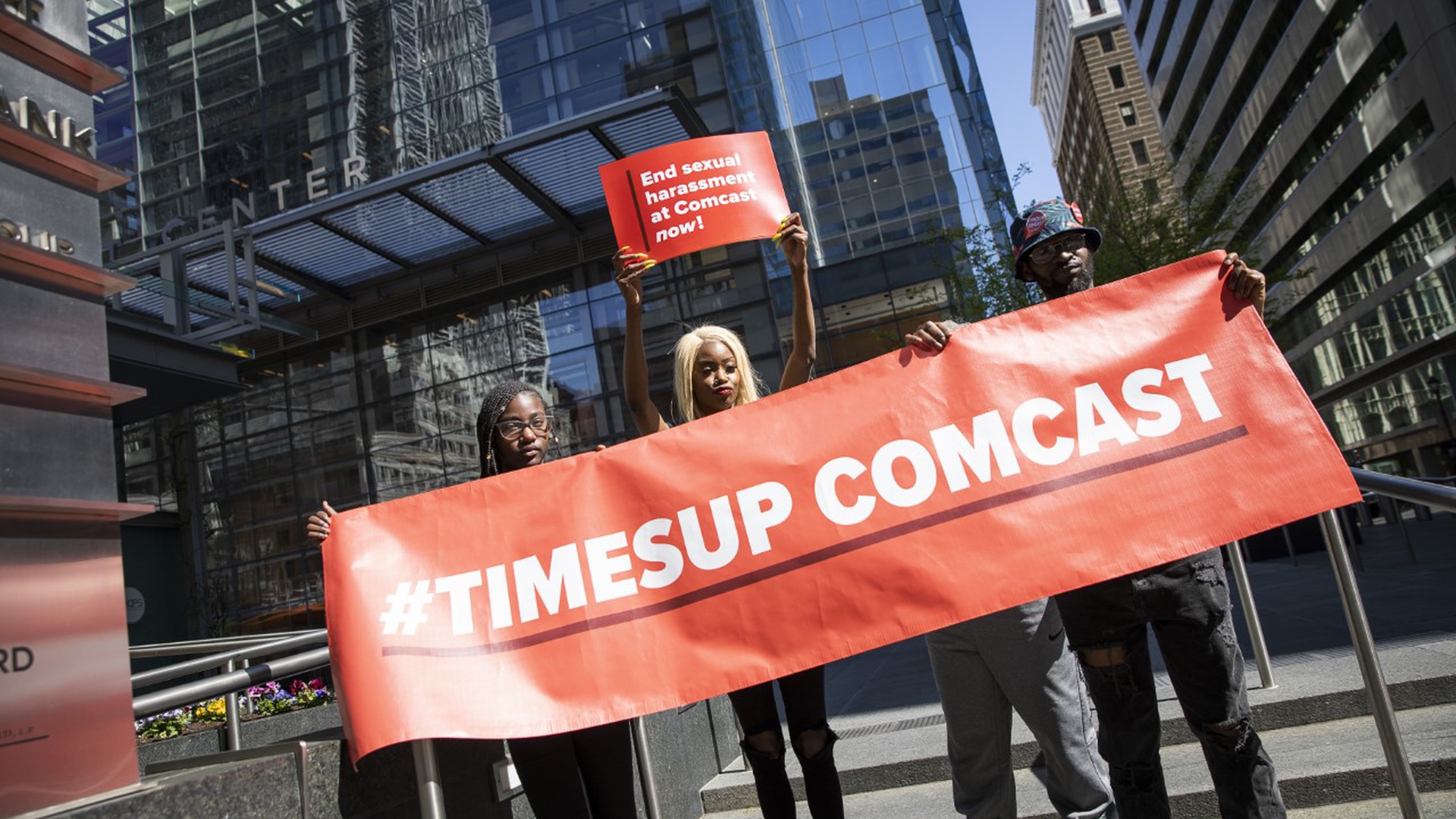Platform Organizing
by
Seamus Bright Grayer,
Enda Brophy (@enda_b)
June 8, 2019
Featured in Logout! (#8)
Digital Tools for Worker Communication

inquiry
Platform Organizing
Digital Tools for Worker Communication
A 2017 Management Report editorial features words of warning for US employers from Alfred T. DeMaria, the publication’s editor and a lawyer specialized in ‘combating union organizational campaigns.’ Knowing ‘how employees can use new media tools, including social media and dedicated apps, to interact among themselves and with union organizers is absolutely necessary,’ DeMaria cautions, moving on to point out exactly what is at stake: ‘Employers who ignore this potential stealth activity risk their union free status.’1
DeMaria’s concern might seem excessive given that the rise of digital technologies in the workplace has occurred alongside a decline in union density across developed countries since the 1980s. Moreover, as ‘platform capitalism’2” gathers strength, it appears well-poised to deliver the latest severe blow to unions. What could DeMaria possibly be worried about in an economy where jobs are sliced into ever-smaller fractal segments, workers are governed remotely by code, and bosses are both distancing themselves from their employees and sealing workers off from each other by technological design?
But perhaps there is some substance to DeMaria’s concerns about the use of digital technologies for the purposes of labour organizing. Certainly the unstated premise of his piece – that a recomposition of the embattled labour movement in a platform-driven economy will necessarily include the use of digital tools – is one we can agree with. Inspired by this possibility, over the last year we have surveyed and assessed emergent platforms for labour organizing in the gig economy and beyond, drawing on interviews conducted with the platforms’ developers and organizers.
Deactivated: Platforms Against Labour
On October 12, Thom Hoffman, an Uber driver with Gig Workers Rising, was tackled to the ground by a security guard at Uber’s headquarters in San Francisco as he attempted to deliver a petition denouncing the company’s “deactivation” policies toward its workers. Those policies, claimed the 3,300 petition signatories, eject Uber drivers from the platform without due process or clear communication as to what their transgression might have been. The incident highlights how corporate platforms such as Uber can and do design their labour management interfaces to simultaneously organize the labour process and isolate, disempower, and silence employees. So, what kind of logic characterizes the operations of platform capitalist companies like Uber as regards communications with and about their workforces?
While platform companies are varied, both internally and among each other, accounts provided by employees and researchers suggest that deactivation is a useful way of describing one of the prime management objectives coded into employee communication interfaces at these companies. Labour-management interfaces across enterprises such as Deliveroo (Cant, this issue), Upwork,3 and Uber4 support a labour process premised upon unprecedented degree of employee surveillance and data extraction; utilization of platform channels for management propaganda; algorithmically-dictated managerial communication; and the channelling, obstruction, or even suppression of worker-to-worker communication. All of these combine to produce the ideal conditions for Alfred DeMaria: An asymmetrical communicative regime,5 where management dominates labour communication both externally and internally, frustrating the workforce’s capacity to share information and organize collectively. And when this system fails there is always the security guard at the door to ensure that orderly communication is restored.
Subverted: Platforms for Labour
Within this communicative regime, however, we are nonetheless beginning to see a proliferation of efforts to develop horizontal, worker-to-worker communication channels. Thus far this has occurred primarily through the appropriation of corporate social media platforms, including Uber and Deliveroo drivers using Whatsapp and Walmart workers using Facebook. Online forums such as UberPeople have emerged as significant spaces for horizontal communication among platform workers.
The recent employee walkouts at Google were coordinated on the company’s own internal messaging system, and in the words of one worker, the organizing drive at Lanetix ‘would not have happened without Slack.’ Finally, the adoption of what we could describe as corporate platforms for labour, like Blind and Glassdoor, which enable workers to communicate anonymously and share information about employers, is also gathering steam as workers seek safe ways to communicate sensitive information behind the employer’s back.
While recognizing the important strategic uses of of corporate platforms for the purposes of labour organizing, there is likely to be more potential in tools designed from within the labour movement. Although the founders of such projects acknowledge and even support the widespread use of corporate platforms in the lives of workers, these efforts at technological innovation from below respond to gaps that have been identified in the digital offerings of the labour movement and allied organizations. After all, while corporate platforms may be useful at times, relying on them exclusively is, as John Evans puts it, ‘like trying to write a novel with crayon. It’s technically possible to do it, but no reasonable person would do so if they had the choice of something better.’
Innovation From Below: Labour Organizing Platforms
The online petition and social networking tool Coworker.org is perhaps the most prominent example of a platform for labour organizing. In the wake of the 2011 union-driven uprising against former Wisconsin Governor Scott Walker, co-founders Jess Kutch and Michelle Miller began to experiment with strategies to help workers, in Kutch’s words, ‘win their campaigns without the support and resources of a traditional labour institution backing them.’ Coworker.org has built a reputation through victories such as forcing Starbucks to change its scheduling policy, helping Uber drivers add a tipping function to their app, and expanding paid parental leave at Netflix.
The platform is also developing a networking feature that enables co-workers to communicate and view each other’s struggles and petitions, and they hope to add a function for workers to survey each other and communicate independently – something Kutch compares to a shop floor newsletter. Coworker.org functions as much more than a digital toolset, however. The platform also provides strategic support and media outreach for people to complement their petitions and help them win changes at work. The organization has played a role in training workers for the recent Google walkout and it partnered with Gig Workers Rising in the deactivation protest mentioned above. In the absence of a union for the overwhelming majority of private sector workers in North America, Coworker.org has positioned itself as a ‘front doorstep’ to the labour movement, helping workers ‘dip their toe into collective action,’ and demonstrating a capacity to highlight new workplace issues among unorganized workforces.
If Coworker.org has modeled itself as the introduction to organizing for workers who are mostly positioned outside the established labour movement, social networking platform Unionbase, co-founded by Larry Williams Jr. and Yonathan Micael, situates itself much more firmly within organized labour. With its beta version released in September 2016, the platform is described in one feature as the ‘Facebook for the labor movement.’ While hype around digital organizing technologies is a staple of media coverage, Williams Jr. describes Unionbase as a ‘global social networking platform for unions and union members, as well as a search engine through which to find unions.’
The platform emerged out of its founders’ experiences in the labour movement, as Williams previously worked at Teamsters Union and has acted as president of the Progressive Workers Union which represents over 200 workers at the Sierra Club, a U.S-based environmental organization. Unionbase’s ultimate goal is to open secure channels of conversation between union leaders, unions and their members, and unions and non-unionized workers. This element of enabling visibility among workers outside the movement is important to the platform’s future plans, as Williams hopes that Unionbase will be able to connect non-unionized workers to each other through the platform’s search function, which equips them to see and reach out to unions and unionized workers in their area.
Another platform that has gained attention is WorkIt, a mobile app developed by the workers and organizers of the OUR Walmart campaign. Co-director Dan Schlademan identifies the platform’s origins in Walmart workers’ desire for ‘a trusted space to find answers to problems that they have at work.’ Designed around an IBM Watson-powered AI chatbot that answers questions regarding the company’s employment policies, WorkIt is envisioned as a hub of worker connection that could supplant Facebook as the organization’s main communication platform. Walmart workers knowledgeable about the company’s policies volunteer to help answer sensitive questions (for example, those about harassment) or those not yet known by the bot. The latter are then used to train Watson to better respond to future requests, helping workers build ‘an ever-expanding database of important information’ that is accessible around the clock to the Walmart workforce.
Schlademan describes the platform as ‘trying to build the infrastructure of what a 21st century labour organization is,’ a resource for workers which, like Coworker.org, can act as an entry point to workplace politics outside the scope of organized labour. With plans for an inter-worker chat feature and improved Q&A functionality, WorkIt is designed to be usable by other organizations that want to borrow the technology for use among their own workforces, creating versions of the app that can be used across sectors and regions.
Platform Organizing
Something important is unfolding in tech sector labour politics. The last two years have seen an outburst of organizing by workers in the high-skill core of tech, including anti-military worker petitions and protest at Google, Salesforce, and Amazon, the aforementioned global walkout in support of the rights of contractors and female employees at Google, the formation and rapid spread of groups such as Tech Workers Coalition, Game Workers Unite, and Tech Action, and a successful union drive crushed by an illegal round of layoffs at Lanetix.
As if the unrest occurring at the upper reaches of digital capitalism’s workforce weren’t concerning enough, workers at the precarious, low-skill periphery of platform companies also took part in intensifying rounds of protest and organizing, including warehouse workers at Amazon, drivers at Uber, cafeteria workers at Facebook, security workers at Google, and delivery workers at Deliveroo. While platform capital enjoys a ‘priority of agency’ in Srnicek’s treatment,6 its platform labour force is not quite the pushover some might have imagined.
The platforms we have surveyed here are but one piece of an emergent and highly varied set of communicative responses by workers to a new organization of labour markets, technologies, and processes. While promising in many respects, they have not yet reached the requisite scale to take part in sweeping wins for labour. All of them, however, display a common set of goals revolving around the establishment of an independent digital infrastructure for horizontal communication among workers and/or for promoting public contestation of corporate communications. As such, these labour organizing platforms have the potential to counteract the disempowering communicative logics of the labour management systems at platform companies. Establishing secure communication channels is a key objective for labour in developing an autonomous digital infrastructure, but organizing outside of commodified information environments is an important goal as well. When asked about the privacy concerns that accompany the creation of a platform of this type like WorkIt, Schlademan claims that all worker-provided information is private and secure: ‘We’re no Cambridge Analytica.’
Nonetheless, these technological experiments face formidable economic headwinds, which may offer a partial explanation for their somewhat ambivalent qualities. Perhaps not surprisingly, there is much about these labour initiatives that mirrors the technologies, logics, and culture of Silicon Valley itself. Crucially, the platforms are subject to the very same ruthlessly competitive logic of network effects, leading to a familiar promotionalism and a conscious mimicking of tech lingo. In the absence of the kind of plush funding enjoyed by market-oriented startups, labour-driven efforts like these even (briefly) enjoyed a variant of venture capital support in the form of The Workers Lab (TWL). Founded in 2014 with the help of a $3 million, 3-year grant from the SEIU and likened by some to a ‘venture capital fund for the worker organizing movement’,7 TWL was an early supporter of Coworker.org, although the organization has since moved away from supporting the development of digital tools for labour organizing.
If funding to nurture these kinds of platforms is hard to come by, another risk is that tech could be seen as a replacement for organizing, a variant of Silicon Valley’s ‘there’s an app for that’ mentality applied to the labour movement. And while it may be true that labour movements cannot afford to ‘not upgrade’ themselves as Williams Jr. points out, others suggest the hype around some of these technologies can be a double-edged sword. Working on tech can soak up time and energy that might be better spent organizing to build worker power. A lesson here might be offered by the Tech Action Working Group of the New York chapter of the Democratic Socialists of America, which, after early efforts at developing a tech tool for the chapter, has moved on to focus on assisting organizing efforts within the local tech sector.
The usefulness of labour technologies versus an emphasis on new models of organizing is a clear point of tension among these projects and others in the labour movement. Kutch argues that a tool like Coworker offers ‘an opportunity… to surface a more three-dimensional picture of what happens in the modern workplace’, one which ‘goes beyond wages and benefits’ and is able to address injuries to worker dignity on the job. While some might question whether campaigning for supermarket employees’ right to have a beard is a worthwhile use of organizing efforts, Coworker.org sees them as but one of the many important struggles for dignity in the 21st century workplace.
In the end, both communication and action are indispensable elements of labour organizing in digital spaces. The secure forms of communication strived for by these platforms – worker-to-worker, worker-to-organizer, and worker-to-public – are crucial, allowing for a much more effective transmission of information and a heightened understanding of the struggles faced by workers on the ground. On the other hand, communication alone is seldom enough to bring about meaningful change at work, and needs to be coupled with activism, organizing, and the development of institutional forms. This balance is on the minds of many of the organizers we spoke to, including Williams Jr. who puts it plainly: ‘The centre and the core of the labour movement is movement building, it’s organizing face-to-face. But we have to supplement that with the use of the newest technology and the internet.’ Platforms for organizing are a necessary but insufficient element in advancing a recomposition of labour movements.
Or we could put it a little differently and say that organizing online is not enough, but organizing digitally is clearly necessary.
-
DeMaria, A. T. (2017). Organizers increase sophistication with digital communications. Management Report for Nonunion Organizations, 40(2): p4. ↩
-
Srnicek, N. (2016). Platform capitalism. Cambridge, UK: Polity. ↩
-
Caraway, B. (2010). Online labour markets: An inquiry into oDesk providers. Work Organisation, Labour & Globalisation, 4(2), 111–125. ↩
-
Rosenblat, A. (2018). Uberland: How algorithms are rewriting the rules of work. Berkeley: University of California Press; Scholz, T. (2016). Uberworked and underpaid: How workers are disrupting the digital economy. Cambridge, UK: Polity. ↩
-
Rosenblat, A., & Stark, L. (2016). Algorithmic labor and information asymmetries: A case study of Uber’s drivers. International Journal of Communication, 10(0), 27. ↩
-
Srnicek, 2016: p10. ↩
-
Sipp, K. (2016). The internet versus the labor movement: Why unions are latecomers to digital organizing. New Labor Forum, 25(2): p91. ↩
Featured in Logout! (#8)
Subscribe to Notes from Below
Subscribe now to Notes from Below, and get our print issues sent to your front door three times a year. For every subscriber, we’re also able to print a load of free copies to hand out in workplaces, neighbourhoods, prisons and picket lines. Can you subscribe now and support us in spreading Marxist ideas in the workplace?
Read next

Technology and The Worker
by
Wendy Liu,
Marijam Didžgalvytė
/
March 30, 2018

